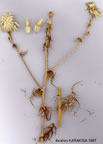| Asteraceae |
 Echinops orientalis |
 Echinops orientalis |
| Echinops L. Echinops orientalis TRAUTV. Ömür: Çok veya İki yıllık Yapı: ot Hayat formu: İlk çiçeklenme zamanı: 6 Son çiçeklenme zamanı: 8 Habitat: stepte, taşlık ve şali yamaçlar, kireçtaşı kayalığı, mağmatik kayalık, nadas tarla, Quercus Minimum yükseklik: 0 Maksimum yükseklik: 1980 Endemik: - Element: İran-Turan Türkiye dağılımı: G. ve Karasal Anadolu Genel dağılımı: Transkafkasya, KB. ve K. İran, Horasan Bulunduğu kareler:C8 |
| E. orientalis Trautv., Echin. Gen. 22, f. 8 (1833). Syn: E. horridus Desf., Cat. PL Horti Paris. 1:94 (1812) nomen; ? E. connatus C.Koch in Linnaea 24:380 (1851); E. viscosus auct. pro parte non DC. (1838). Figure 23, p. 615. Stems several, much branched, up to l(-l.5) m, ridged, relatively slender, brownish, below with a dense indumentum of very short capitate glandular hairs diminishing above and arachnoid tomentose or glandular throughout. Leaves oblong-lanceolate in outline, 2-3-pinnatifid or pinnatisect; lamina usually densely glandular above, rarely not and then arachnoid, below lanate with glandular hairs on veins; spines numerous, variable in size. Heads 4-7 cm. Capitulum 20-30 mm; brush shorter or longer than outer phyllaries, 6-20 mm. Phyllaries 20-25; outer 8-12 mm, glandular, arachnoid or glabrous; median 15-20 mm; innermost loosely connate to about middle, or more, 20-25 mm, usually without long spines. Corolla blue, pale blue or whitish; tube 12-15 mm; lobes 8-12 mm. Pappus bristles connate to about 1/2 their length. Fl. 6-8. Stony and shaly slopes in steppe, limestone and igneous rocks, fallow fields, Quercus woods, roadsides, nr s.l.-1980 m. Type: [Iran] circa Derbentum, Eichwald in herb. Ledebour (LE, photo!). S. & Inner Anatolia (commonest in East). A4 Ankara: Kalecik to Tuney, D. 25083! A5 Amasya: nr Amasya, 400 m, Bornm. 1890:1776! A6 Tokat: Tokat, D. 24879! A7 Giresun: Şebinkarahisar, D. 20457! A8 Çoruh: Yusufeli to Sarıgöl, Hevek Dere, 800 m, D. 47687! A9 Kars: d. Kağizman, Akçay to Gaziler, 1100 m, D. 46885! B4 Ankara: Ankara, nr Dolapdere, Alinoğlu 26! B6 Maraş: d. Çardak, Ericek, D. 20388! B7 Erzincan: Erzincan to Kelkit, 1500 m, D. 31911! Tunceli: d. Pülümür, 1 km from Pülümür, 1450 m, Hub.-Mor. 16351 (form with purplish setae on stem)! B8 Erzincan: Aşkale to Tercan, 1700 m, D. 32658! B9 Bitlis: Tatvan, 1750 m, D. 24541! C5 Adana: Ceyhan to Erzin, 33 km E. of Ceyhan, 60 m, Hub.-Mor. 12052! C6 Adana: d. Feke, Göksu gorge below Himmetli, 700-800 m, D. 19856! Hatay: Belen to Antakya, 13 km E. of Belen, 100 m, Hub.-Mor. 12053 (form with unusually dissected leaves)! C7 Urfa: d. Viranşehir, 11 km N.W. of Ceylanpinar, 360 m, Hub.-Mor. 14663! C10 Hakkari: 2 km from Şemdinli to Yüksekova, 1550 m, D. 45034! Transcaucasia, N.W., N. Iran, Khorassan. Ir.-Tur. element with Mediter-ranean penetrations. Closely related to E. viscosus DC. and as in that species very variable in size and in the degree of leaf dissection; forms with strongly and little dissected leaves may occur in the same population. Most specimens from the east and south-east of Anatolia are fairly uniform in facies but those from theAmanus and the west of the species range show much diversity and approach E. viscosus; in the latter areas introgression may occur. Although the type of E. connatus has not been traced, and may be lost, the original description (and the type locality - A9 Çoruh, Ardanuç) suggests that it is not different from E. orientalis. |